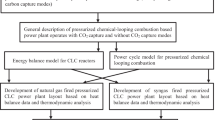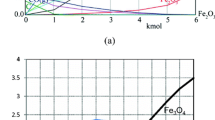Abstract
Of the various clean combustion technologies with carbon capture and sequestration (CCS) possibilities, chemical-looping combustion (CLC) promises to be an efficient and attractive method for oxidizing fuels without the energy penalty required for oxygen separation from air. The present work reports on a detailed thermodynamic analysis of 1,500 MWth, syngas-fueled, CLC-based power generation system which includes a provision for CCS. Taking account of the exothermic nature of the reaction of syngas with the selected oxygen carrier, NiO, in the fuel reactor, operating temperatures of air and fuel reactors are fixed at 900 and 908 °C, respectively. The CLC reactor system operates at atmospheric pressure on fuel/air side, and generates supercritical steam. An overall plant lay-out has been prepared such that the steam side, which is rated at 240 bar/538/552/566 °C, is very similar to that of a conventional thermal power plant making retrofitting a distinct possibility. A detailed analysis of the ideal cycle shows that a highly promising gross cycle efficiency of 41.22 % and net cycle efficiency of 36.77 % can be achieved after accounting for the energy cost of CO2 compression to 110 bar to facilitate CCS.






Similar content being viewed by others
Abbreviations
- CLC:
-
Chemical-looping combustion
- T:
-
Temperature at any point, °C
- CLCSC:
-
Chemical-looping combustion steam cycle
- Tr :
-
Reference temperature, °C
- Mi :
-
Mass flow of component i, kg/s
- CPm :
-
Heat capacity of metal, kJ/kg.K
- m:
-
Mass flow of gas or liquid in Table 2, kg/s
- a, b, c & d:
-
Coefficients of temperature polynomial in Eq. (9)
- CPi :
-
Heat capacity of component i, kJ/kg.K
- h:
-
Enthalpy, kJ/kg
- \({\text{q}}_{\text{Air\, in }}\) :
-
Thermal energy flow in air entering the air reactor, kW
- \({\text{q}}_{\text{Depleted\, air}}\) :
-
Thermal energy flow in oxygen-depleted air, kW
- qMeOx :
-
Thermal energy flow in oxygenated metal oxide, kW
- qMe :
-
Thermal energy flow in reduced form of metal oxide, kW
- qOx :
-
Thermal energy produced by metal oxidation reaction, kW
- \({{\rm{q}}_{{\text{AR}}\,{\text{Extract}}}}\) :
-
Thermal energy extracted from air reactor by cooling fluid, kW
- \({{\rm{q}}_{{\text{Fuel}}\,{\text{in}}}}\) :
-
Thermal energy flow in fuel entering the air reactor, kW
- qRed :
-
Heat produced by metal reduction reaction, kW
- mfuel :
-
Mass flow rate of fuel, kg/s
- LHVfuel :
-
Lower heating value of fuel, MJ/kg
- \({{\rm{P}}_{{\rm{steam}}\,{\text{turbine}}}}\) :
-
Total power produced by CLCSC steam turbines, MW
- \({{\rm{P}}_{{\rm{water}}\,{\text{pump}}}}\) :
-
Power consumed to pump water at required pressure, MW
- \({{\rm{P}}_{{\rm{C}}{{\rm{O}}_{\rm{2}}}{\rm{comp}}}}\) :
-
Power consumed for carbon dioxide compression, MW
- ηGross :
-
Gross efficiency of CLCSC power plant
- ηNet :
-
Net efficiency of CLCSC power plant
- HE1:
-
Steam super heat exchanger
- HE2, HE3:
-
Steam reheaters
- MeO:
-
Metal oxide
- Me:
-
Reduced form of metal oxide
- e:
-
Electrical (related to power, as in MWe)
- AR:
-
Air reactor
- Ox:
-
Oxidation
- Red:
-
Reduction
- r:
-
Reference
- m, n:
-
Oxidized and reduced states of O2 carrier, respectively
- th:
-
Thermal (related to power, as in MWth)
- α, β & γ:
-
Coefficients of temperature polynomial in Eq. (10)
References
Adánez J, Abad A, Garcia-Labiano F, Gayan P, Diego DLF (2012) Progress in chemical-looping combustion and reforming technologies. Prog Energy Combust Sci 38:215–282
Adánez J, de Diego LF, García-Labiano F, Gayán P, Abad A (2004) Selection of oxygen carriers for chemical-looping combustion. Energy Fuel 18:371–377
Adánez J, García-Labiano F, de Diego LF, Gayán P, Abad A, Celaya J (2005) Development of oxygen carriers for chemical-looping combustion. In: Thomas DC, Benson SM(ed) Carbon dioxide capture for storage in deep geologic formations—results from the CO2 capture project, Elsevier, Oxford (UK),Vol 1 Chapter 34 pp 587–604
Adánez-Rubio I, Abad A, Gayán P, García-Labiano F, de Diego LF, Adánez J (2013) The fate of sulphur in the Cu-based chemical-looping with oxygen uncoupling (CLOU) process. Appl Energy 113:1855–1862
Bandyopadhyay A (2011) Amine versus ammonia absorption of CO2 as a measure of reducing GHG emission: a critical analysis. Clean Technol Environ Policy 13:269–294
Barin I (1989) Thermochemical data of pure substances, part II. Hemisphere Publishing Corporation, New York
Chikkatur, Ananth P, Ambuj D Sagar (2007) Cleaner power in India: towards a clean-coal-technology Road map. Discussion Paper 2006–2007, Mass.: Belfer Center for Science and International Affairs, Cambridge
Damartzis T, Papadopoulos AI, Seferlis P (2014) Optimum synthesis of solvent-based post-combustion CO2 capture flow sheets through a generalized modeling framework. Clean Technol Environ Policy. In press. doi:10.1007/s10098-014-0747-2
Davison J, Thambimuthu K (2009) An overview of technologies and costs for carbon dioxide capture in power plants. Proc IMechE Part A 223:201–212
El-Wakil MM (2010) Power plant technology. Tata McGraw Hill, New Delhi
Fan LS (2010) Chemical-looping system for fossil energy conversions. Wiley, New Jersey
Hasaneen R, Elasyed NA, Barrufet MA (2014) Analysis of the technical, microeconomic, and political impact of a carbon tax on carbon dioxide sequestration resulting from liquefied natural gas production. Clean Technol Environ Policy. In press. doi:10.1007/s10098-014-0735-6
Hatanaka T, Matsuda S, Hatano H (1997) A new-concept gas-solid combustion system “MERIT” for high combustion efficiency and low emissions. In: Proceding of the 32nd Intersociety energy convers energy conference (IECEC-97). Honolulu, Hawaii; pp. 944–948
IEA (2006) World energy outlook (2006) International Energy Agency (IEA).IEA PublishingWeb.www.iea.org/publications/freepublications/publication/name,3650,en.html. Accessed 10 Dec 2014
IEA (2013) Developments in circulating fluidised bed combustion, IEA Clean Coal Report No 13/7 June 2013. http://www.iea-coal.org.uk/documents/83172/8753/Developments-in-circulating-fluidised-bed-combustion,-CCC/219, Accessed 30 March 2014
IPCC (2005) Special report on carbon dioxide capture and storage. Prepared by working group III of the intergovernmental panel on climate change. Cambridge University Press, New York
Ishida M, Jin H (1994) A new advanced power-generation system using chemical-looping combustion. Energy 19:415–422
Ishida M, Zheng D, Akehata T (1987) Evaluation of a chemical-looping combustion power-generation system by graphic energy analysis. Energy 2:147–154
Jayanti S, Saravanan V, Sivaji S (2012) Assessment of retrofitting possibility of an Indian pulverized coal boiler for operation with Indian coals in oxy-coal combustion mode with CO2 sequestration. Proc IMechE Part A 226:1003–1013
Jenni KE, Baker ED, Nemet JF (2013) Expert elicitations of energy penalties for carbon capture technologies. Int J Greenh Gas Control 12:136–145
Johansson M (2007) Screening of oxygen-carrier particles based on iron-, manganese-, copper and nickel oxides for use in chemical-looping technologies. Doctoral Thesis, Chalmers University of Technology, Göteborg, Sweden
Kanniche M, Gros-Bonnivard R, Jaud P et al (2010) Pre-combustion, post-combustion and oxy-combustion in thermal power plant for CO2 capture. Appl Therm Eng 30:53–62
Knacke O, Kubaschewski O, Hesselmann K (1991) Thermochemical properties of inorganic substances. Springer, Berlin
Krishna Priya GS, Bandyopadhyay S (2013) Emission constrained power system planning: a pinch analysis based study of Indian electricity sector. Clean Technol Environ Policy 15:771–782
Kronberger B, Beal C. Morin JX, Hofbauer H (2004) Design, hydrodynamic testing and scale-up recommendations of a conceptual large-scale chemical-looping combustion power plant. In: Proceedings of the 3rd Conference on Carbon Sequestration. Alexandria, USA
Li F, Fan LS (2008) Clean coal conversion processes–progress and challenges. Energy Environ Sci 1:248–267
Linderholm C, Abad A, Lyngfelt A, Mattisson T (2008) 160 h of chemical-looping combustion in a 10 kW reactor system with a NiO-based oxygen carrier. Int J Greenh Gas Control 2:520–530
Liszka M, Ziebik A (2010) Coal-fired oxy-fuel power unit process and system analysis. Energy 35:943–951
Loughlin DH, Yelverton WH, Dodder RL, Miller CA (2013) Methodology for examining potential technology breakthroughs for mitigating CO2 and application to centralized solar photovoltaics. Clean Technol Environ Policy 15:9–20
Lyngfelt A, Leckner B, Mattisson T (2001) A fluidized bed combustion with inherent CO2 separation; application of chemical-looping combustion. Chem Eng Sci 56:3101–3113
Lyngfelt A, Kronberger B, Adánez J, Morin JX, Hurst P (2004) Development of oxygen carrier particles for chemical-looping combustion, design and operation of a 10 kW chemical-looping combustor. In: Proceeding 7th Int conference of greenhouse gas control technology (GHGT-7). Vancouver, Canada
Markström P, Linderholm C, Lyngfelt A (2013) Operation of a 100 kW chemical-looping combustor with Mexican petroleum coke and Cerrejon coal. Appl Energy 113:1830–1835
Mayer F, Bidwe AR, Schopf A, Taheri K, Zieba M, Scheffknecht G (2013) Comparison of a new micaceous iron oxide and ilmenite as oxygen carrier for chemical-looping combustion with respect to syngas conversion. Appl Energy 113:1863–1868
Moldenhauer P, Rydén M, Mattisson T, Younes M, Lyngfelt A (2013) The use of ilmenite as oxygen carrier with kerosene in a 300 W CLC laboratory reactor with continuous circulation. Appl Energy 113:1846–1854
Naqvi R (2006). Analysis of natural gas-fired power cycles with chemical-looping combustion for CO2 capture. Doctoral Thesis, NTNU, Trondheim, Norway
Nayef G, Redhouane H (2010) Principles of chemical engineering processes. CRC press, New York
Reddy VS, Kaushik SC, Tyagi SK (2014) Energetic analysis and evaluation of coal-fired supercritical thermal power plant and natural gas-fired combined cycle power plant. Clean Technol Environ Policy 16:489–499
Seepana S, Jayanti S (2009) Optimized enriched CO2 recycle oxy-fuel combustion for high ash coals. Fuel 102:32–40
Sivaji S, Jayanti S (2010) Steam-moderated oxy-fuel combustion (SMOC). Energy Convers Manag 51:1981–1988
Ströhle J, Orth M, Epple B (2013) Design and operation of a 1 MWth chemical-looping plant. Appl Energy 113:1490–1495
Tong A, Bayham S, Kathe VM, Zeng L, Luo S, Fan LS (2013) Iron-based syngas chemical-looping process and coal-direct chemical looping process development at Ohio State University. Appl Energy 113:1836–1845
VTT (2013) Utility scale CFB for competitive coal power: CFB800. www.vtt.fi/files/sites/flexiburncfb/cfb800_brochure.pdf, Accessed 30 March 2014
Wall TF (2007) Combustion processes for carbon capture. Proc Combust Inst 31:31–47
Wall T, Liu Y, Spero C et al (2009) An overview on oxyfuel coal combustion—state of the art research and technology development. Chem Eng Res Des 87:1003–1016
Winslow AM (1977) Numerical model of coal gasification in a packed bed, Symposium (international) on combustion, Vol 16 pp. 503–513
Yan J, Chou SK, Desideri U, Tu ST, Jin HG (2013) Research, development and innovations for sustainable future energy systems. Appl Energy 112:393–395
Author information
Authors and Affiliations
Corresponding author
Rights and permissions
About this article
Cite this article
Basavaraj, R.J., Jayanti, S. Syngas-fueled, chemical-looping combustion-based power plant lay-out for clean energy generation. Clean Techn Environ Policy 17, 237–247 (2015). https://doi.org/10.1007/s10098-014-0781-0
Received:
Accepted:
Published:
Issue Date:
DOI: https://doi.org/10.1007/s10098-014-0781-0




